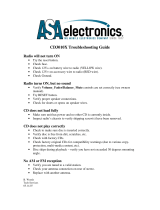
For your Safety in Using the AVN2210p
Warnings and caution signs, illustrated below, are posted throughout this manual as well as on the AVN2210p. They
show safe and correct ways to handle the product so as to prevent personal injury to you, others and to avoid property
damage.
Please read through the "Warning" and "Caution" notes before reading the owner's manual for operational features
and functions.
Please read all materials such as manuals and warranties that have come with the product.
Eclipse will not be held liable for unsatisfactory product performance due to failure to follow these instructions.
This sign indicates a situation in which incorrect handling or disregard
of this sign may result in death or serious personal injury.
This sign indicates a situation in which incorrect handling or disregard
of this sign may result in personal injury or may result solely in
damage to property.
WARNING
● Do not modify this system for use other than that specified herein. Also, do not deviate from the installation
procedures described herein; Eclipse will not be held liable for damages including, but not limited to serious
injury, death or property damage resulting from installations that enable unintended operation.
● This main unit requires 12V DC and should only be installed in a vehicle with a 12V negative ground electrical
system. Any other installation use other than its intended use may cause severe damage to the main unit as well
as shock or personal injury.
● Never install this main unit where it will interfere with safe operation of the vehicle. Never block the drivers' view.
Do not install main unit where it may interfere with operation of the brakes, the steering or any safety systems,
including seat belts and air bags.
● Before drilling holes in a vehicle for installation, you must confirm the locations of pipes, tanks, electrical wiring,
and other vehicle systems and components to ensure that there will be no interference or contact. In addition,
you must also apply rust prevention and leak prevention measures at the drilling area. Otherwise, fire or electric
shock could occur.
● When installing main unit do not remove or alter existing vehicle fasteners, including nuts, bolts, screws, clips,
and fittings. Never detach, move or alter existing vehicle wiring, including electrical grounds and straps.
Alteration of existing vehicle components may make vehicle unsafe to operate.
● Before installation, remove the negative (-) battery terminal to prevent shocks, electrical arcing, fires, and
damage to vehicle wiring and the main unit you are installing.
● Secure wiring with non conductive tape or plastic ties so that wires do not interfere with vehicle operation,
including brake pedal, gear shifter and steering. Position wires so that they will not be rubbed, abraded, or
damaged by moving vehicle components, including power seats.
● To avoid main unit and vehicle damage, including fire, never supply power to installed main unit in a way which
will overload the capacity of an existing vehicle circuit. Never leave a power supply wire or connection
uninsulated. Always install supplied fuses, circuit breakers, and relays.
● Air bags are a vital part of an safety system. Never install main unit in a way which will alter air bag wiring or
interfere with air bag deployment. Air bags must function properly in the event of an accident.
● When installation is complete, test all vehicle electrical systems for proper operation, including lights, horn,
brake lights, and emergency flashers.
● For your protection, never use a power drill without safety glasses or goggles. Debris or broken drill bits may
cause severe eye injuries, including blindness.
● Use electrical tape to insulate the ends of all wires, even if not used. Proper insulation prevents arcs, shocks
and fires.
● Some devices require the use of batteries. Never install main unit where young children can get access to
batteries. If a battery is swallowed, seek immediate medical attention.
● When the vehicle is in motion, never take your eyes off the road to make adjustments to the main unit. You must
pay attention to the road to avoid accidents, do not let the operation or adjustment of the main unit distract you
from proper vehicle operation.
● The driver should not look at the screen while driving. Accidents may occur as a result of not paying attention to
your driving.
Warning
Caution
























